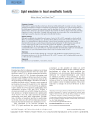

LAST is generally considered to be resistant to conventional modes of resuscitation. Cardiovascular collapse is the most life-endangering complication of local anesthetic (LA) absorption or intravascular injection during regional anesthesia. Intravenous lipid emulsion (ILE) is a novel method for treating local anesthetic systemic toxicity (LAST) that also shows promise as an effective antidote for other lipophilic drug poisonings. Future studies will shape the evolving recommendations for lipid emulsion in the setting of non-local anesthetic drug overdose. While protocols exist for administration of lipid emulsion in the setting of local anesthetic toxicity, no optimal regimen has been established for treatment of acute non-local anesthetic poisonings. Lipid emulsion therapy is gaining acceptance in emergency rooms and other critical care settings as a possible treatment for lipophilic drug toxicity. Recent case reports of successful resuscitation suggest the efficacy of lipid emulsion infusion for treating non-local anesthetic overdoses across a wide spectrum of drugs: beta blockers, calcium channel blockers, parasiticides, herbicides and several varieties of psychotropic agents. Based on this hypothesis, lipid emulsion has been considered a candidate for generic reversal of toxicity caused by overdose of any lipophilic drug. The predominant theory for its mechanism of action is that by creating an expanded, intravascular lipid phase, equilibria are established that drive the offending drug from target tissues into the newly formed 'lipid sink'. © Veterinary Emergency and Critical Care Society 2015.Intravenous lipid emulsion is an established, effective treatment for local anesthetic-induced cardiovascular collapse. Intravenous lipid emulsion marijuana mechanical ventilation toxicity. Intravenous lipid emulsion treatment may be beneficial due to the lipophilicity of SC. Significant clinical intervention may be necessary.

Communication with the owners 5 days following discharge revealed that the dog was apparently normal.īased on this case and other reports in the literature regarding human exposures, SC ingestion may result in more severe clinical signs than marijuana ingestion in dogs. The dog was eating and walking with no ataxia, had a normal mentation at approximately 33 hours following presentation, and was discharged home at that time. The dog became rousable and was weaned from mechanical ventilation approximately 15 hours following presentation. Intravenous lipid emulsion therapy was administered as a bolus (1.5 mL/kg) and continued as a continuous rate infusion (0.5 mL/kg/h) for a total of 6 hours. Mechanical ventilation was provided due to hypoventilation and periods of apnea. Initial treatment included IV fluids and supplemental oxygen. The owner reported that the dog was exposed to an SC containing Damiana leaf, Marshmallow leaf, and Athaea leaves. The initial diagnostic evaluation (eg, CBC, serum biochemistry profile, venous blood gas, and electrolyte determination) revealed a respiratory acidosis and thrombocytopenia. Neurologic status deteriorated to comatose mentation within 2 hours of presentation. The initial physical examination identified marked hypothermia (32.7☌ ), intermittent sinus bradycardia (60/min), stuporous mentation with intermittent aggression, and severe ataxia. To describe the effects of suspected synthetic cannabinoid (SC) toxicosis and the response to intravenous lipid emulsion (ILE) therapy in a dog.Ī 2-year-8-month-old male Boxer dog was evaluated at an emergency hospital for progressive ataxia and inappropriate mentation.


 0 kommentar(er)
0 kommentar(er)
